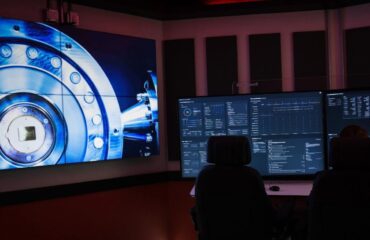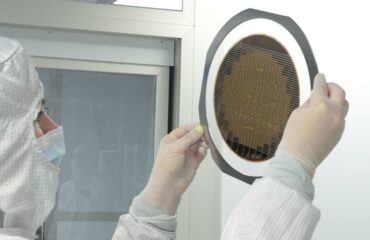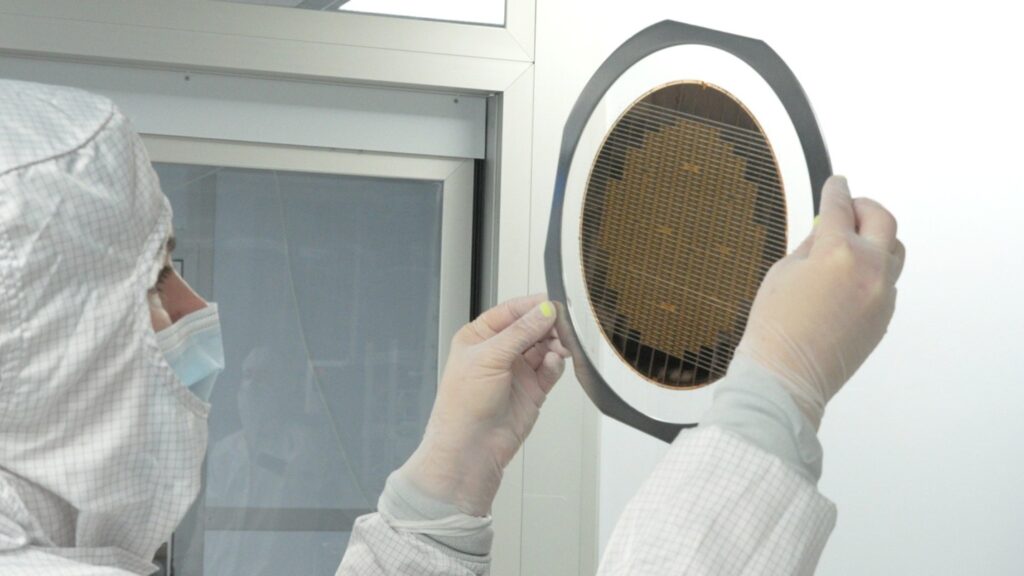
The development of diamond films advances the use of photons of light for quantum computer networking. Quantum computers have achieved a major speed advantage in calculating molecular combinations and permutations for the development of life-saving drugs, and photonics is showing increasing promise for creating stable circuits and connecting quantum computers. Image of laboratory scientist from IonQ.
By James Myers
On June 9, quantum computing company IonQ announced that its partnership with drugmaker AstraZeneca, GPU-maker Nvidia, and Amazon Web Services has achieved a 20 times speedup in computational drug design.
It’s an acceleration that will reduce 30 days worth of computing to 1.5 days, delivering major potential to the development of new drugs. Drug development is extremely expensive and time-consuming, so using quantum processing units (QPUs) like those of IonQ to speed the processes and reduce costs could spur discoveries of many life-saving drugs in the near future.
 IonQ is a publicly traded quantum computing company now celebrating its 10th anniversary. In September, the growing company completed a $1 billion acquisition of Oxford Ionics, and over the past year has acquired three other companies and a majority stake in a fourth.
IonQ is a publicly traded quantum computing company now celebrating its 10th anniversary. In September, the growing company completed a $1 billion acquisition of Oxford Ionics, and over the past year has acquired three other companies and a majority stake in a fourth.
Modelling drugs is a complex process that requires simulating vast numbers of combinations and permutations among chemical components and studying their interactions with the human body.
The complexities can defy even the world’s most powerful supercomputers, and as the size of the drug molecule increases so do the complications as more atoms are added to the chemical chains.
For complex calculations, the quantum bit (called a “qubit”) has far greater computational capacity than classical computer bits, owing to the still mysterious properties of quantum mechanics. The qubit can simultaneously calculate a vast number of probabilities between “1” (on) and “0” (off) states, whereas the classical computer bit requires time to switch between 1 and 0 and is limited to calculating in only one of the two possible states at any single time.
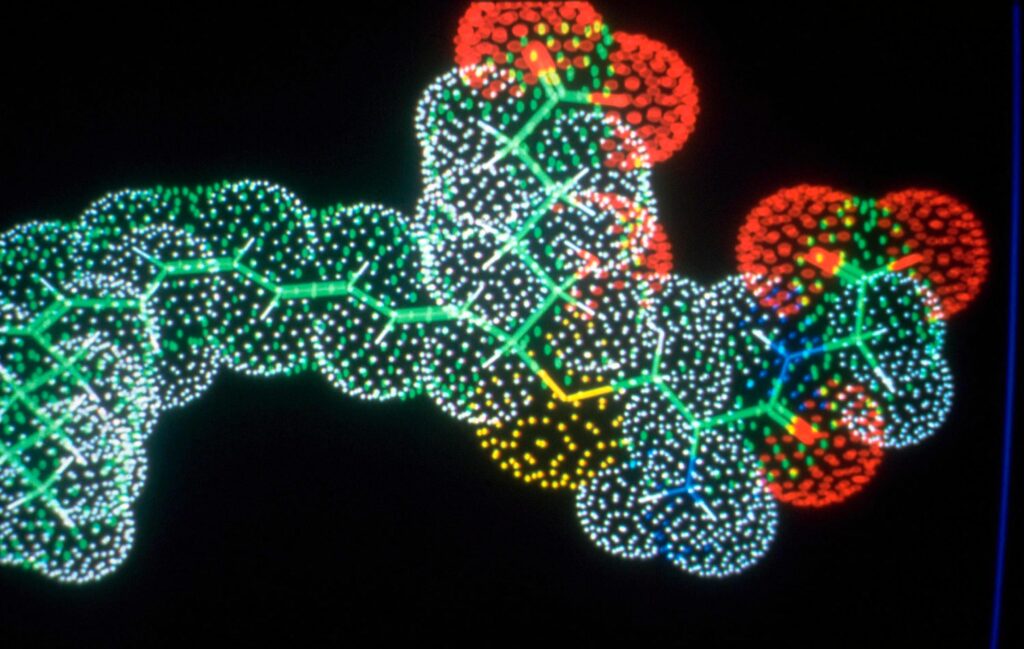
Drugs are made by chaining atoms in specific configurations. The speed and data processing volume of quantum computers are helping to unlock the increased computational complexities of modelling drugs as more atoms are added to the chain. Molecular image from AstraZeneca.
More recently, IonQ’s networking division announced a breakthrough in the use of synthetic diamond materials to accelerate quantum networking and expand the capabilities of quantum computing by connecting many machines. The company stated, “In collaboration with Element Six, a De Beers Group company specializing in synthetic diamond materials for industrial applications, the team has developed high-quality, quantum-grade diamond films. These films allow diamond-based devices to be made using standard semiconductor manufacturing techniques.”
Semiconductors are the basis of computing, with crystal-like structures that transmit, or conduct, electricity between the limits of insulating materials. Although they are poor electrical conductors, diamonds are crystals formed from carbon and are emerging as an important prospect for quantum technologies. For example, a May 2025 study entitled Recent progress in hybrid diamond photonics for quantum information processing and sensing highlights the ability of cavities in diamonds, called point defects, to act as “powerful tools for a broad range of quantum technologies. These defects are promising candidates for quantum information science, serving as deterministic single-photon sources and solid-state quantum memories.”
Memory and networking are major challenges for widespread quantum computing use.
The qubit’s simultaneous operation in all probabilities between 1 and 0 gives great speed and computational power to the quantum computer, but it is also a burden that makes it extremely difficult to develop systems that can store memory of the machine’s vast numbers of calculations. A quantum computer produces outputs far more quickly than any regular computer hard drive could handle – even one with near infinite capacity for the quantity of data. And since the volume of data and the transmission rate far exceed any fibre cable capacity, we will need different networking methods than the internet and fibre-based networks that connect today’s computers.
IonQ describes the diamond films as crucial for quantum memory systems and networking quantum computers with photonic light-operated interconnections. Currently, the company’s quantum computer operates 36 algorithmic qubits, with a 64-bit qubit in the works that the company’s CEO says will provide the computational equivalent of 1 billion graphic processing units (GPUs) now used for the heaviest computing tasks like language processing.
“Foundry-compatible, quantum-grade diamond films change the game in photonic interconnects, compute processors, and quantum networking,” said Niccolo de Masi, Chairman and CEO of IonQ. Since the diamond films can be incorporated in QPUs using the same tools and processes already in use for GPUs, de Masi stated, “This innovation will allow us to mass-produce consistent, high-performance systems designed for commercial quantum networks.”
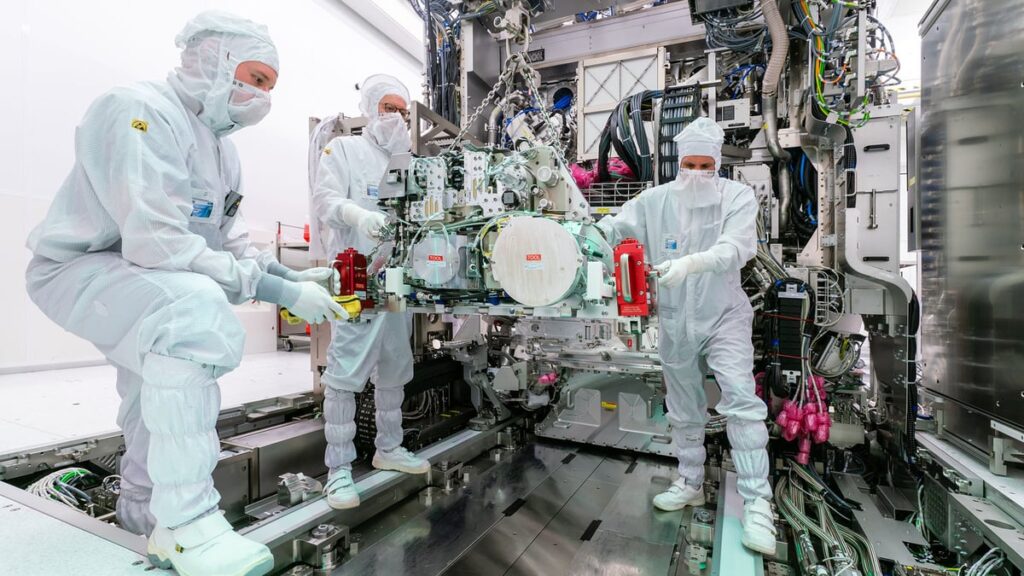
Fabrication of computer processors is an intricate and extremely expensive process. Tiny chips contain as many as 100 layers, requiring a manufacturing facility (called a “foundry”) that is free from environmental contamination. Image: ASML.
The use of photonics in quantum computing continues to propel quantum information science toward the goal of creating stable quantum computing circuits.
Although there have recently been some significant advancements in stabilizing the circuits, they remain fragile and susceptible to disconnection (called “decoherence”) by even the slightest disturbances from the surrounding environment. It is thought that when stable quantum circuits can be maintained, the ability to connect one million or more qubits would unleash the power of the quantum computer at industrial scale.
 For the time being, when it’s a struggle to maintain connections between more than a few thousand qubits, photonic qubits are showing promise for stable quantum circuits in the near future. Unlike IonQ’s qubits that consist of trapped ions – which are atoms frozen in place by laser beams – quantum computing company Xanadu uses particles of light (called “photons”) for its qubits. In June, Xanadu announced “a significant breakthrough in creating qubits that are robust and error resistant.”
For the time being, when it’s a struggle to maintain connections between more than a few thousand qubits, photonic qubits are showing promise for stable quantum circuits in the near future. Unlike IonQ’s qubits that consist of trapped ions – which are atoms frozen in place by laser beams – quantum computing company Xanadu uses particles of light (called “photons”) for its qubits. In June, Xanadu announced “a significant breakthrough in creating qubits that are robust and error resistant.”
Our August article, New Type of Quantum Bit, the Photonic GKP Qubit, Propels Development of Error-free Quantum Computing, reported on Xanadu’s latest news in its drive to create one million qubits, which the company says its photonic technology can handle.
Xanadu announced the creation of a new type of qubit, called a GKP qubit, which can be encoded in a quantum harmonic oscillator that measures fluctuations in light waves. Quantum measurements can be made efficiently in the changing wavelengths of light, accurately capturing a wide range of probabilities as the photonic qubits oscillate in the full range of possible states between 1 and 0.
The GKP qubit, together with the use of photonics in quantum networking, could make photonics a game-changer for full-scale quantum computing. It’s perhaps not hard to imagine that light, which is the fastest thing in the universe – operating at 299,792,458 metres per second, with zero resistance – could harmonize transmission times in circuits both within and between quantum computers, stabilizing them to the point of full industrial potential.
Reduced energy use will be a significant added benefit of industrial-scale quantum computing.

Requiring massive amounts of energy, computationally intensive tasks like training supercomputers for large language models have prompted Microsoft to recommission the Three Mile Island nuclear reactor. Above, workers remove radioactive contamination released in the 1979 Three Mile Island nuclear meltdown. Image: Wikipedia .
“Our ion trap quantum computers are probably using one-tenth of the energy of a GPU to solve similar problems,” IonQ’s Niccolo de Masi said in an interview with Bloomberg. “I always think that it’s a bit of a shame that Microsoft is recommissioning Three Mile Island to power their data centres. That can’t be the future, right?” Masi asked about the massive power demands of today’s supercomputers for training large language models like ChatGPT, and for operating generative AI.
Three Mile Island is the nuclear power plant in Pennsylvania that suffered a meltdown in 1979 in the worst nuclear accident in U.S. history. Fortunately, the release of radioactive iodine and gases was limited to the point that there were no detectable health effects on plant workers and the public. In our October 2024 article, Watt Matters: Addressing the Energy Problem in Data Centers, we reported on the International Energy Agency’s assessment that three years ago, in 2022, data centres were consuming between 1-1.3% of the world’s energy. The accelerating rate at which new data centres are being announced in recent news means that their global energy consumption is rapidly multiplying, with no means of sustainably generating power to feed the increasing thirst for electricity.
It remains to be seen whether light, the combination of light and diamonds, or some other method can make circuit decoherence a thing of the past and, at the same time, render power-hungry data centres obsolete. At the current rate of advancement, however, it may not be long from now before the curtain to our quantum computing future opens and we’ll see photonics in the spotlight at centre stage.


